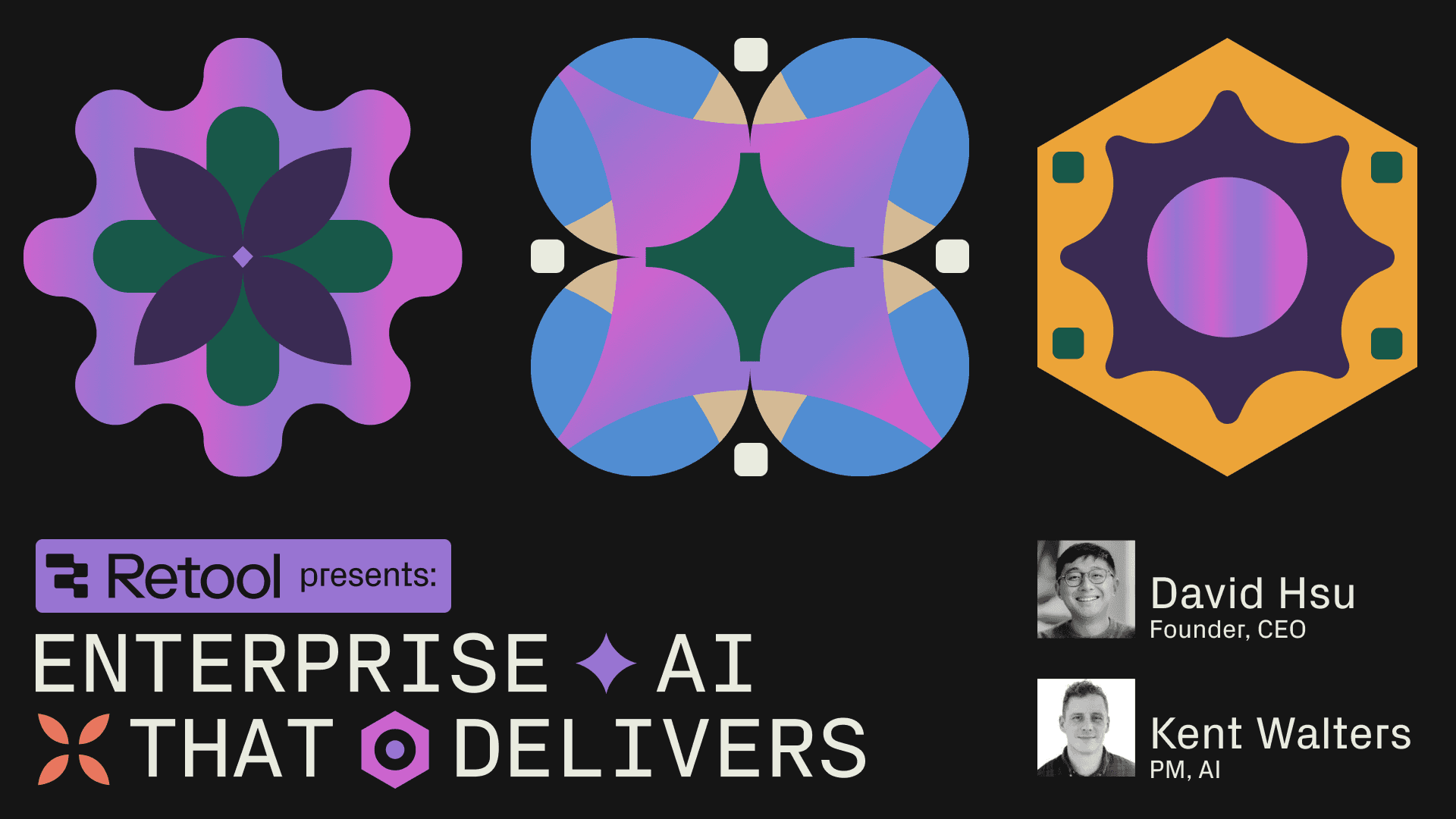AI agents represent a fundamental shift in how software can work. These autonomous systems don't just execute predefined tasks—they can reason, make decisions, and orchestrate sophisticated workflows that traditionally required human intelligence. For businesses, this promises to transform everything from customer service to data analysis to process automation.
But turning this promise into a production-ready reality has been brutally complex. Teams spend countless hours wrestling with integration challenges, building security guardrails, and crafting monitoring systems. Instead of building valuable solutions, they get stuck managing technical plumbing—or they never get started at all.
Retool Agents changes this paradigm. With Agents, builders can bundle prompt engineering, tool use, human-in-the-loop controls, and production observability to transform how businesses operate.
We remove the burden of low-level implementation details so you can focus on your agent’s actions, not just how to keep all the technical pieces from falling apart.
By unifying the development experience, Agents bridges the gap between proof-of-concept and production-ready automation, turning abstract potential into concrete business value without requiring a team of specialists just to keep the lights on.
The launch of Agents represents a significant step toward making AI automation practical for real business use cases. In this post, we’ll explore how Agents work, share examples of what you can build, and demonstrate why this approach matters for the future of business automation.
Ready to see what AI can really do for your business? Start building with Agents today and read more from our CEO on how we’re already helping companies automate millions of hours of work.
Let’s say you’re building a support agent. What does it need to do? It needs to understand customer questions, search through your knowledge base, pull up relevant tickets or issues, and provide accurate responses. It might even need to create tickets when it can’t resolve an issue directly.
Building a proof of concept is relatively simple. You’ll need to iterate on prompts, connect to a handful of data sources, and build a simple orchestration layer that allows the agent to search and respond. Within hours, you can create something that impressively handles the happy path for common questions.
Then comes the hard part: turning this promising demo into production-ready software. The challenges multiply rapidly:
When the agent needs to make complex decisions about which tools to use and when to stop searching, your simple loops turn into tangled decision trees. Error handling alone becomes a massive undertaking. What happens when an API times out? When a JSON response is malformed? When the agent gets stuck in circular reasoning?
Your proof of concept might work with one knowledge base, but now stakeholders want connections to Intercom, Zendesk, GitHub, JIRA, and internal databases. Each integration means custom authentication, error handling, and response parsing. The elegant pattern you started with disappears under mountains of boilerplate.
The agent needs different permissions for different users and contexts. It should answer questions for anyone, but only create tickets for authorized users with appropriate permissions. Building this parallel permission system means duplicating logic that already exists in your core applications.
When your agent fails in production, you have no visibility into why. Was it a token limit issue? Did the prompt change its effectiveness? Did an external API return unexpected data? Without proper logging and debugging tools, troubleshooting becomes nearly impossible.
Sometimes you don’t want your agent making consequential decisions autonomously, such as creating tickets or sending emails. But adding approval workflows means building yet another system—notifications, state management, timeouts, and UI components that track pending actions and their approval status.
What started as a compelling proof of concept is now bogged down in infrastructure work. Your team spends more time maintaining the plumbing than improving the agent’s actual capabilities or business value. And at the end of it all, you still have an agent with reliability issues, and that is single use—you don’t have a pattern for building the other agents your business requires.
These challenges aren’t unique to support agents. They affect any AI agent project trying to bridge the gap between demonstration and deployment. The fundamental problem isn’t building something that works once; it’s building things that work reliably, securely, and observably at scale.
With Retool Workflows, you can integrate LLM reasoning alongside logical building blocks—queries, conditionals, and triggers. It’s possible to build agentic workflows (or constrained agents) in Workflows, but when building true agents we found ourselves and our customers reimplementing the same patterns every time we tried. Retool Agents uses the same building blocks as Workflows under the hood, but provides an additional orchestration layer (the agent’s loop), new primitives (predefined and custom tools), and stock user experiences (first-class chat) to make building and using agents as simple as possible.
But agents don’t solve every problem. In reality, most real AI use cases are served by some combination of deterministic workflows coupled with non-deterministic agents at different points in the process.
Rather than building a monolithic agent that tries to solve everything, Agents and Workflows give you the power to compose these patterns together and build the right tool for your task.
For example, you might have:
- A workflow orchestrating an entire process,
- That calls multiple agents,
- Who can call other workflows or other agents as tools.
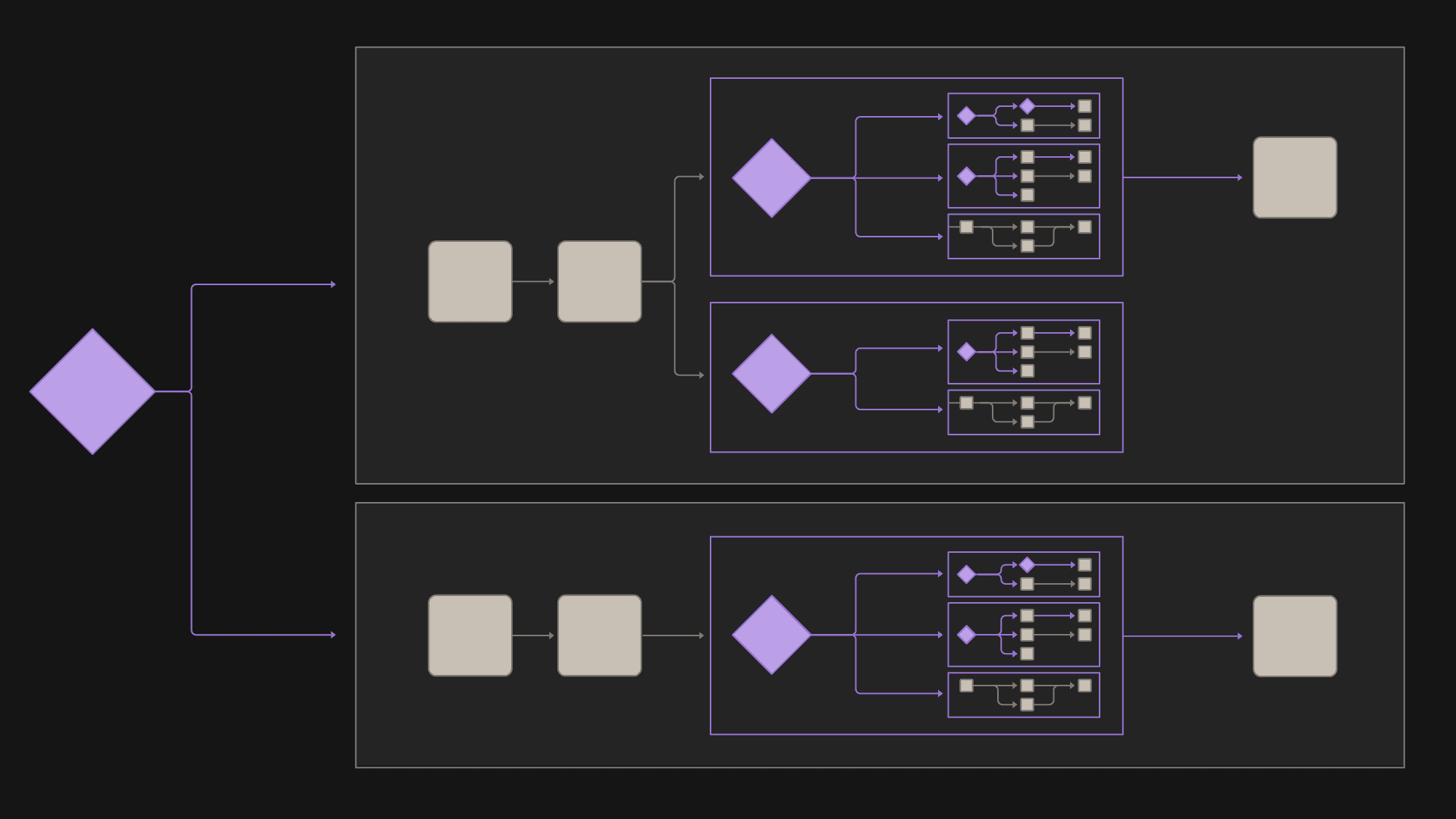
e combined Retool Agents and Workflows approach mirrors how real business processes work in practice. Consider the customer support process: it begins with triage, branches into specialized resolution paths based on issue type, and may require approvals and escalations along the way. A support ticket system might start with an agent that analyzes incoming requests, classifies them by department and urgency, and then routes them to specialized workflows or other agents designed to handle specific issue types.
You can develop, test, and refine each of these components independently, but they still function as part of the whole system. Rather than building this as a single massive system, you can model it as interconnected components that each handle specific parts of the process. This approach also avoids the reliability and performance issues that emerge when you try to cram too many tools into a single agent—specialized agents with focused responsibilities are more predictable and easier to debug.
This model’s power becomes undeniable as you scale. What starts as a simple ticket router can evolve into a sophisticated support automation platform by adding specialized flows for different product areas, customer tiers, or issue types. Since each component uses the same fundamental abstractions, you can expand from five steps to five hundred without changing your development approach.
This contained system also provides natural boundaries for human oversight. You can implement different approval requirements for different paths, allowing routine queries to be handled automatically while ensuring sensitive operations require explicit approval.
Retool Agents provides a unified surface that merges authoring, tooling, governance, evaluations, and observability, built on Retool's enterprise-grade foundation. Instead of stitching together separate products and building custom infrastructure, teams can focus on creating agents that solve business problems.
The Retool approach starts with simplicity. It is simple to configure instructions and models and attach tools to your agent that are based on existing Retool primitives without having to reason through cognitive architectures. This removes the typical orchestration overhead that plagues agent development.
Under the hood, the platform automatically manages the complex loop of tool selection, execution, and reasoning, freeing developers from writing boilerplate code for these patterns. The agent handles the decision-making process about which tools to use and when the task is complete, but you don’t need to manually code this logic. If you ever need more control, you can drop down into a backend function, which you provide to your agent as a tool.
Agents launches with an extensive set of ready-to-use tools, inheriting all the trusted queries, APIs, and workflows that Retool customers have built over time. All current Retool integrations are available as agent tools, alongside prebuilt tools like Google Calendar, web search, code execution, email, Retool Storage, data visualization, and others.
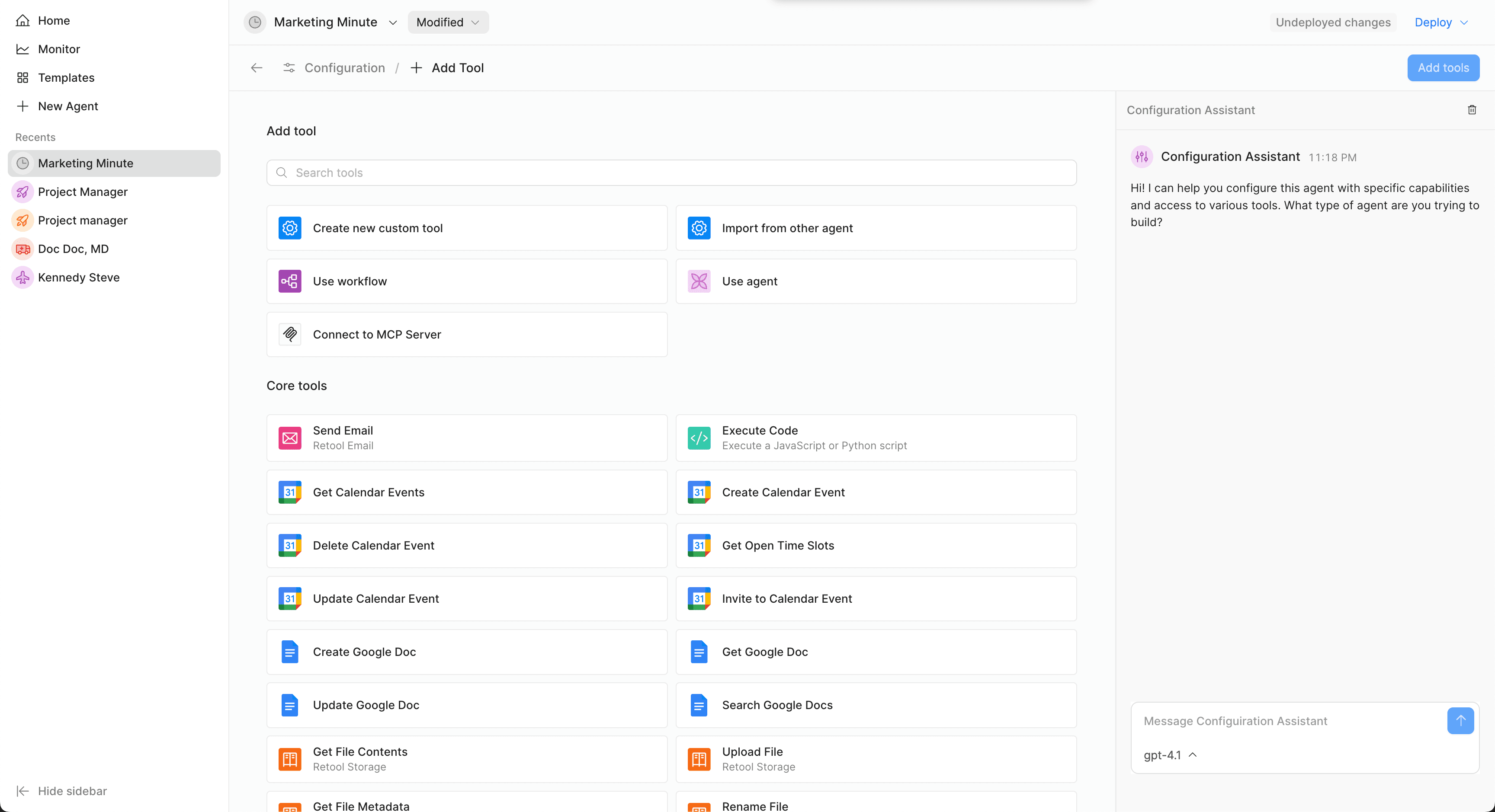
You can create custom tools through any REST or database connector. Leverage your existing Retool data sources with a single click, turning any API or database into a capability your agent can access and reason about.
Security and permissions are baked into the platform rather than bolted on afterward. Agents operate on behalf of users, so they can never use tools, take actions, or use data sources without explicit permission. Even with permission, Agents enables human review and approval of actions before execution, which can be configured for every tool call.
Beyond basic execution metrics, Agents provides visibility into your agent’s operations. You get deep insight into everything your agent does, with transparency beyond simple logs.
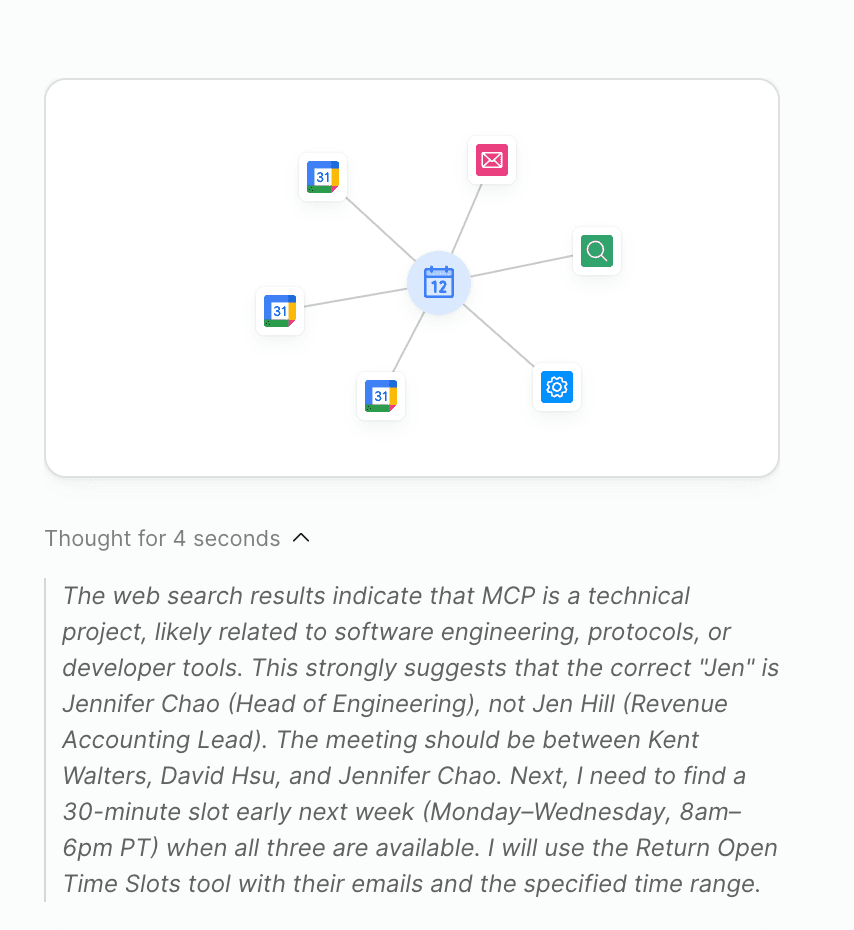
- Decision transparency: Examine the agent’s reasoning process through thought logs, helping you understand why it chose specific actions or tools in any situation.
- Performance metrics: Track tokens, latency, and cost metrics at both the individual run and aggregate levels, giving you an understanding of your agent's resource consumption and ROI.
- Systematic evaluation framework: Built-in programmatic and LLM-as-judge reviewers and evaluation datasets let you measure agent performance against your business needs.
- Comprehensive audit trails: Complete logs and chat replay capabilities enable you to debug each step of the agent’s execution path.
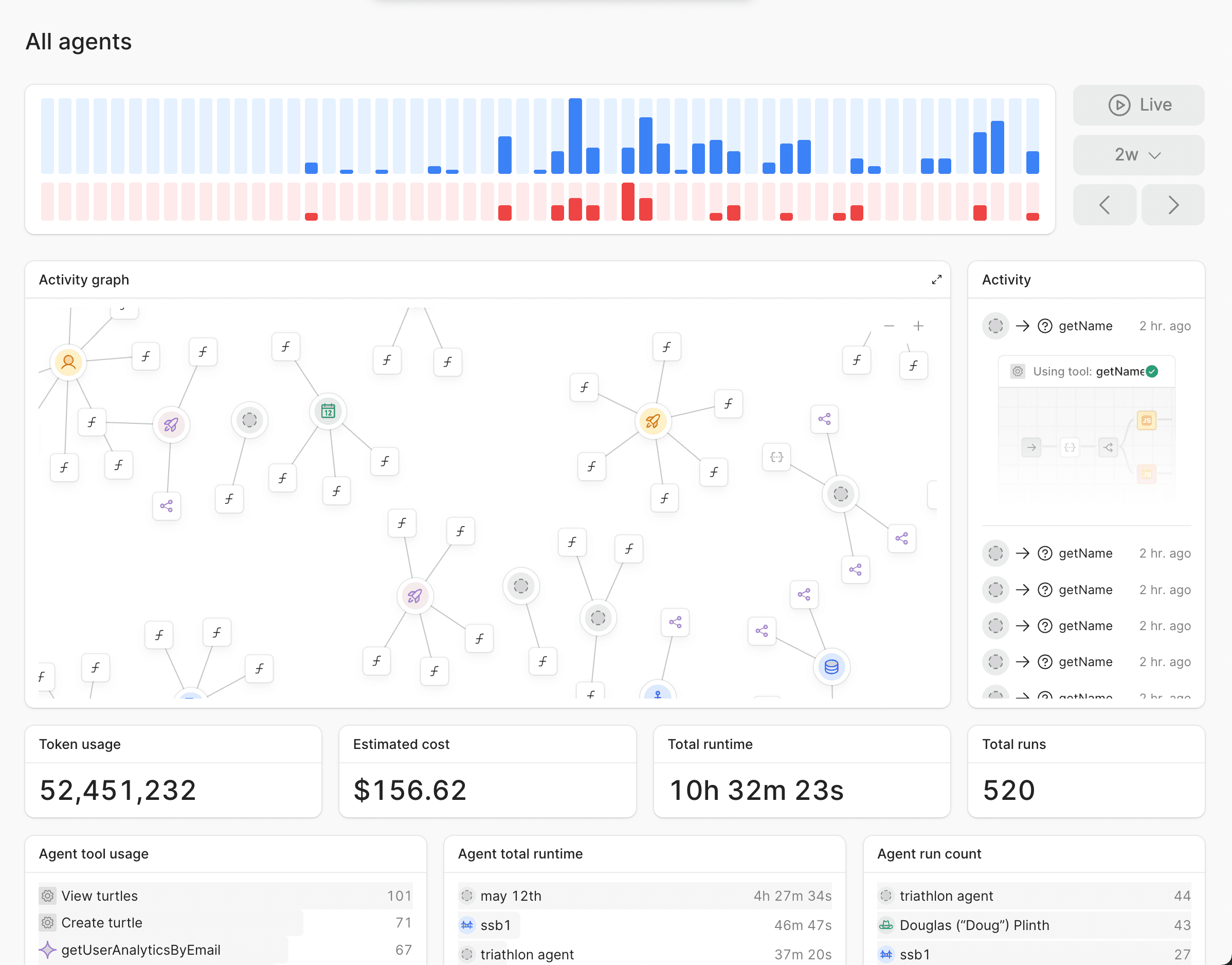
This switches agent development from a black box into a transparent, data-driven process. Rather than guessing at improvements, you can identify issues, optimize prompts, and track performance gains against baseline measurements.
The power of Agents becomes clear when examining concrete patterns that demonstrate how to convert abstract potential into production value. Let’s explore two real-world use cases, unpacking what each agent does, how the pieces fit together, and the specific decisions that make them work.
The challenge: Engineering teams often spend hours each week answering repetitive platform questions, diverting resources from core development.
- Entry point: The agent receives queries directly from Slack through a webhook integration.
- Decision layer: Based on the query content, the LLM determines which knowledge sources to consult.
- Tool selection: The agent chooses between searching Confluence documentation, Intercom customer conversations, or GitHub issues.
- Human checkpoint: Before creating any tickets, the agent requires explicit human consent.
- Completion logic: The LLM determines when it has gathered sufficient information to resolve the question or when escalation is needed.
The agent’s handling of the decision-making process makes this pattern powerful. Rather than following a fixed process, it dynamically assesses the context of each question. For technical inquiries about APIs, it might prioritize GitHub first. For user-facing features, it might start with Intercom records of similar questions.
By requiring human consent before ticket creation, the system maintains guardrails while it automates work. The results are measurable: faster first-response times, consistent documentation references, an auditable trail of support interaction, and less drudgery for humans.
The challenge: Meeting coordination across busy teams consumes hours of administrative time through manual back-and-forth communications.
- Natural language processing: The agent begins by parsing free-form scheduling requests from chat or email.
- Context collection: It automatically pulls relevant information about participants’ preferences and constraints.
- Calendar integration: Using the pre-built Google Calendar tool, the agent finds available time slots across multiple calendars.
- Proposal generation: It creates optimized meeting proposals based on preferences and availability.
- Human approval: Before any invitations are sent, the agent presents options and waits for user confirmation.
- Execution: Only after approval does the agent send invitations via the email tool.
The intelligence in this system lies in how it balances automation with control. The LLM makes decisions about time slot prioritization, meeting duration, and participant importance, but always keeps humans in the approval loop before taking actions that impact others.
A system like this delivers immediate value. What previously required dozens of emails becomes a single request with one approval step. Execs and their staff and reclaim their time while maintaining full visibility and control over the scheduling process.
These examples illustrate a shift in how teams can think about agent implementation. Rather than building monolithic solutions, focus on understanding the decision points where AI reasoning adds value:
- Identify which decisions the LLM should make (tool selection, information synthesis, termination conditions).
- Map out the tools and data sources needed to support those decisions.
- Establish clear governance boundaries around autonomous vs. human-approved actions.
- Build incrementally, starting with the core decision loop and adding complexity as needed.
Agents makes this pattern-based approach accessible by bundling the infrastructure, governance, and tooling together, letting you focus on the business logic rather than the plumbing.
Using a platform that unifies agents, workflows, and tools into a single fractal system, customers create patterns of automation that grow through composition rather than custom code.
This approach solves the most persistent challenges in agent development:
- The orchestration burden disappears with built-in reasoning loops.
- Tool integration becomes seamless through the Retool ecosystem.
- Security and permissions are handled at the platform level.
- Comprehensive observability gives visibility into both execution and decisions.
- Human-in-the-loop controls become a natural part of the system architecture.
The result? A huge reduction in the time and effort required to move from concept to production. What might take months of custom development can be implemented in days using familiar Retool patterns and infrastructure.
Start building with Agents today. Try our starter templates to experience how this powerful abstraction can transform your business processes. Then, customize them with your data sources to create solutions tailored to your specific needs. Turn your agent ideas into production value—without the endless plumbing.
Learn more about our broader vision for AI-powered development and how Retool is helping companies automate knowledge work watch our product launch event, and join me for a special episode of our community series Builder Talks on May 29.
Reader


